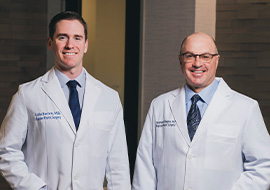Common Questions
What cosmetic services are available at Klapper Eyelid & Facial Plastic Surgery? What is the difference between an eyelid lift, blepharoplasty and ptosis surgery? Will eyelid surgery correct my droopy eyebrow? Will insurance help pay for my surgery?
Restylane® and Perlane®
Natural Cosmetic Dermal Fillers
What is Restylane®?
Restylane® is a gel of hyaluronic acid generated by Streptococcus bacteria. Hyaluronic acid is a natural substance found in all living organisms. The type of hyaluronic acid in Restylane® is called NASHA (non-animal stabilized hyaluronic acid). NASHA is a patented, non-animal stabilized hyaluronic acid in clear gel form which is biosynthetically produced by a laboratory fermentation process.
Is Restylane® Safe?
Restylane® is approved by the United States Food and Drug Administration (U.S. F.D.A.) for the treatment of moderate to severe facial wrinkles and folds. It has been used by plastic surgeons worldwide since 1996. It is non-animal based and allergy testing is not required. Is has been widely studies and been shown to have a well-defined safety profile.
How is Restylane® different from Botox®?
Restylane® is a natural, cosmetic filler of skin folds and soft tissue defects. The nasolabial folds and lips are commonly treated areas. In contrast, Botox® is a purified protein that weakens facial muscle contraction to reduce wrinkles in the overlying skin. Botox® is used most frequently around the eyes and in the forehead. Many patients benefit from facial rejuvenation with both Botox® and Restylane®.
Which areas of my face might benefit from Restylane® or Perlane®?
Restylane® is approved by the U.S. F.D.A. for treatment of moderate to severe facial wrinkles and folds. The nasolabial folds are a commonly treated area. Fullness and definition of the lips can be successfully enhanced with Restylane®. Perlane® is a similar product but with larger gel particles designed for deeper injection. Dr. Klapper or Dr. Bacorn will help assist you in deciding which product may work best for you.
How long does Restylane®/Perlane® last?
Average treatment effects last six to nine months, perhaps slightly longer with Perlane®. Successful use of Restylane® and Perlane® may require numerous treatments over several months. Following the initial injection, semi-annual maintenance injections are typically necessary to achieve and maintain the desired volume correction. Touch-up treatments are occasionally indicated to correct irregularities. The duration of effect varies from patient to patient. Some patients may not retain the correction at all. Still others may only appreciate the results for less than six months.
What Should Patients do prior to Treatment?
Over-the-Counter medications including: Aspirin, non-steroidal anti-inflammatory medications (such as Ibuprofen), high doses of Vitamin E, fish oil, St. John’s Wort, some red wines, and many herbal supplements may increase the risk of bleeding and bruising with injections. Avoidance of these medications and products the week prior to your injections may be helpful.
Prescription medications such as coumadin, Plavix, and other “blood thinners” also increase the risk of bleeding and bruising with treament. You should not stop any medication prescribed by your physician without consulting the prescribing doctor prior to holding the medication.
The Injection Procedure
Restylane® is injected into the dermal layer of skin in very small amounts through an ultra fine needle. Topical anesthetic cream applied 15 minutes prior to the procedure is helpful to limit the discomfort associated with injections of the nasolabial folds. Our doctors also provide a topical cryo (freezing) spray to some of his patients that may be particularly sensitive to the injections. Some patients undergoing lip augmentation may require local anesthetic injected under the lip. Our team will help you determine which technique may be right for you.
There are certain expectations that can be associated with this injection procedure. These may include: bleeding, swelling and bruising of the injected areas, redness of the skin, moderate discomfort at the time of injection, skin discoloration and recurrence of local cold sores. These symptoms usually resolve within 1-3 days of injection of skin areas and within 3-7 days of lip injections.
What are the Complications?
Some of the rare but possible complications include: bleeding, infection, asymmetry of the injections sites, over or under correction of the injected areas, allergic reaction, and the need for further invasive or surgical procedures. Approximately 1 in 5,000 patients experience hypersensitivity reactions that may result in swelling, redness, tenderness, and acne-like rashes in or around the injected areas. These symptoms may appear days to weeks after the injection and usually last at least 2 weeks.
How much do Restylane® and Perlane® Treatments Cost?
Costs will vary from patient to patient based on the amount of filler required to meet an individual patient’s specific needs. An average treatment session may cost approximately $600 (range $ 375-$1,100). You and Dr. Klapper or Dr. Bacorn can decide how much Restylane® or Perlane®will be necessary to achieve your goals and determine all of your costs prior to your procedure.
Our Experience
Klapper Eyelid & Facial Plastic Surgery has extensive experience with soft tissue fillers (such as collagen and Cymetra®). Dr. Klapper has been performing cosmetic Restylane® injections since its U.S. F.D.A. approval more than 10 years ago. While administering Restylane® is not technically difficult, surgeon experience with Restylane® is critical to limit the risks of unwanted effects and to achieve optimal results.
Klapper Eyelid & Facial Plastic Surgery treats disorders, injuries, and other abnormalities of the eyelids, eyebrow, tear duct system, eye socket, and adjacent areas of the mid and upper face.
